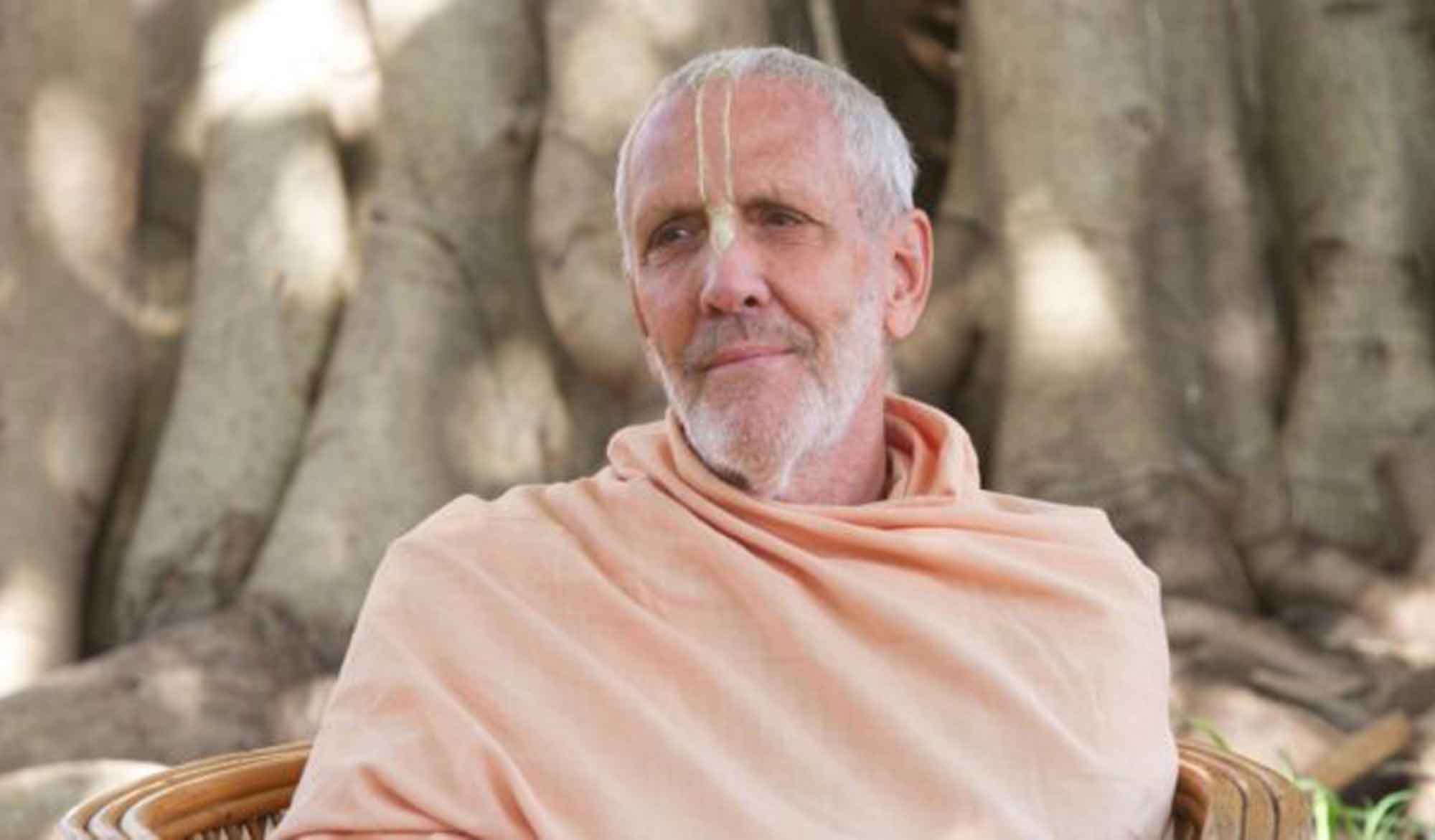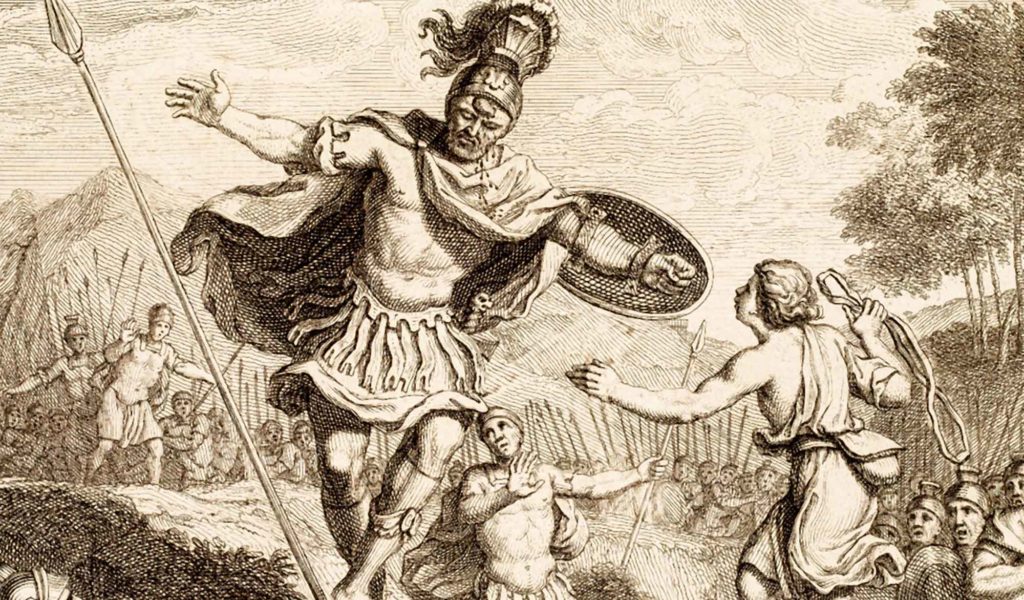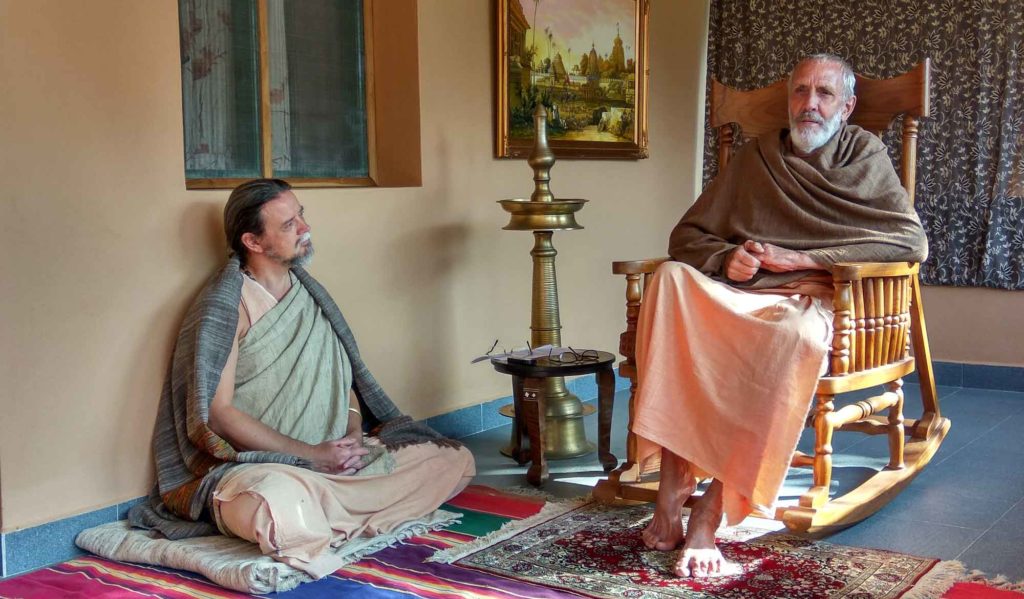Overview
In this article, Swami B.V. Giri gives an account of Śrīla Bhakti Gaurava Narasiṅgha Mahārāja's return to India and his tirobhava (disappearance pastimes) in South India.
On Thursday, January 2nd, 2020 at 1:31pm, corresponding with saptamī during the month of Pauṣa, Caitanyābda 534, our beloved Guru Mahārāja, Oṁ Viṣṇupāda Paramahamsa Parivrājakācārya Śrī Śrīmad Bhakti Gaurava Narasiṅgha Mahārāja entered the eternal midday (madhyāhna-līlā) of Śrī Śrī Rādhā-Mādhava. He was surrounded by his disciples, friends and well-wishers who were loudly singing the holy names. According to astrological calculations, Śrīla Guru Mahārāja departed at an auspicious moment, indicating that he is no longer a participant of this material realm.
Śrīla Guru Mahārāja had been performing pastimes of illness for about five months while establishing an āśrama in Vermont, USA. During that time, he extended his mercy to many disciples and well-wishers, giving them final instructions and blessings. Although he experienced many physical disturbances, Śrīla Guru Mahārāja remained mentally alert and at the end of December 2019, he decided to return to Govindajī Gardens in India. How all this unfolded was nothing short of miraculous. Indeed, everyone that personally witnessed this could see the divine hand of Lord Śrī Kṛṣṇa at play. All the devotees of our mission are deeply indebted to Guru Mahārāja’s very dear friend, Śrīpāda Bhakti Abhaya Gosvāmī Mahārāja and Kuñjavihārī Prabhu, the object of Guru Mahārāja’s affection. Both these devotees performed outstanding guru-sevā during Śrīla Guru Mahārāja’s illness pastimes in Vermont. Gosvāmī Mahārāja and Kuñjavihārī Prabhu were able to bring Guru Mahārāja back to India against all odds. All the devotees in Vermont – Kalki, Mañjarī, Dāruka, Yogamāyā, Vāsudeva, Anaṅga, Bhakta-priya, Kṛṣṇa Kīrtana, Daniella, Līlā-smaraṇa, Vraja-kiśora, Vṛnda, as well as Hari Prasāda and family, all helped in so many ways to make this seemingly impossible journey a reality. Other devotees such as Prahlāda Prabhu and Anurādhā also contributed in many ways to serve Guru Mahārāja. Our humble daṇḍavats to all these Vaiṣṇavas and all the other innumerable devotees who helped.
On returning to India, a group of devotees helped Kuñjavihāri serve Guru Mahārāja around the clock – Advaita Ācārya Prabhu, Gaura-Gopāla Prabhu, Rūpānuga Prabhu, Caitya-Guru Prabhu Caitanya Dāsa Prabhu and Śyāma-kuṇḍa Prabhu. Our tireless Syāmasundara ‘Sevā-vigraha’ Prabhu also did tremendous service in organising so many important legal and managerial necessities. Guru Mahārāja’s godbrother Śrīpada Viṣṇu Mahārāja had arrived a few days earlier and Guru Mahārāja’s dear friend and godbrother, Śrīpāda Prema Kiśora Prabhu had also come with his wife Paṇḍita Mātājī. Prema Kiśora Prabhu led kīrtana every night for Guru Mahārāja’s transcendental pleasure. We should also mention here the very important services rendered by Mukunda Prabhu, Thaldīpa Kṛṣṇa Prabhu, Muralī-Kṛṣṇa Prabhu, Yaśodā Mātājī, Dr. Phanimādhava and Dr. Rājendra.
On the day of his disappearance from this mortal world, for about six hours, Śrīla Guru Mahārāja’s eyes remained open, without blinking. Then, five minutes before his departure, all his vital signs returned to normal again and at 1:31pm, his eyes closed for the last time. Above his head were the shoes of his beloved Gurudeva, Śrīla Prabhupāda – a request that he had made some months before. He left to the sound of the mahā-mantra being sung by about 40 devotees, including disciples, godbrothers, godsisters, friends and well-wishers.
His transcendental form was bathed, he was dressed in new cloth and tilaka was applied in twelve places. Then the sannyāsa-mantra was written on his chest and he was decorated with candana and flower garlands. At 6:30pm hundreds of people flocked to take his darśana, offering garlands and flowers at his lotus feet. For many hours, the devotees and many members of the public sat outside on the verandah of his bhajana-kuṭīra chanting the mahā-mantra. On hearing of his departure, many beautiful words of appreciation came from godbrothers, godsisters and admirers from all corners of the globe.
The following morning at around 8:00am, Śrīla Guru Mahārāja was carried in procession from his room for darśana of Śrīla Prabhupāda, Śrī Śrī Gaura-Rādhā-Mādhava, Jagannātha, Gaura-Gadādhara and Yoga-Narasiṁha. As his transcendental form came to Govardhana Hill, the bamboo under the basket he was being carried in, began to slip and the devotees carrying him were forced to put him down between Govardhana and Govinda Kuṇḍa while they fixed the bamboo. Those who are of keen spiritual intelligence will understand that this was no accident – it was indicative of the desire of our pūrvācāryas to find residence at the foot of Govardhana Hill where they engage in the nitya-sevā of the Divine Couple.
His divine form was then lowered into the samādhi-pītha, where he was offered worship and naivedyam by Kuñjavihārī Prabhu. All the devotees then took antya-darśana (last darśana) of Śrīla Guru Mahārāja. After the samādhi-pītha was filled, a photo of Śrīla Guru Mahārāja was established and the first arati was offered by Syāmasundara Prabhu, during which time Gaura Gopāla Prabhu sang the newly composed samādhi ārati song for the pleasure of Guru Mahārāja and the devotees.
For all his disciples and followers, Śrīla Guru Mahārāja was like a blazing sun, dissipating the darkness of ignorance. His articles, books and lectures are the invaluable legacy that have inspired devotees around the world, and will continue to do so for years to come. But now the sun of Śrīla Guru Mahārāja has set, and we, his followers, are drowning in a deep, dark ocean of intense pain and separation, bereft of shelter. We have lost our spiritual guide and our dearmost friend – the thought of never seeing him again in this lifetime has broken our hearts. We will never again be able to sit with him, discuss philosophy, laugh or honour prasādam together. Everything around us feels bleak and lifeless.
śūnyāyate mahā-goṣṭhaṁ girīndro ‘jagarāyate
vyāghra-tuṇḍāyate kuṇḍaṁ jīvātu-rahitasya me
“Now that I no longer have the preserver of my life, the land of Vraja has become desolate, Govardhana Hill has become like a great serpent, and Rādhā-kuṇḍa appears like the gaping mouth of a ferocious tiger.” (Prārthanāśraya-caturdaśaka, verse 11, by Raghunātha Dāsa Gosvāmī)
Our only consolation is that he is now with his Guardians, Śrīla Prabhupāda, Śrīla Śrīdhara Mahārāja and Śrīla Purī Mahārāja – either preaching with them on another plane, or with them in the green pastures of Vraja-bhūmi happily serving the Divine Couple, Śrī Śrī Rādhā-Dāmodara.
He has left us with the priceless gift of devotional service and the treasure of Gauḍīya siddhānta, and all his sincere and dedicated followers will be able to find the strength that they require and attain his direct, personal association by faithfully adhering to his instructions and propagating them.
Swami B.V. Giri
Related Articles
- The True Spirit of Separation by Śrīla Bhakti Pramoda Purī Gosvāmī
- Śrīla Swami Mahārāja Attains the Dust of Vraja by Śrīla Bhakti Pramoda Purī Gosvāmī
- The Disappearance of Śrīla Śrīdhara Mahārāja by Śrīla Bhakti Pramoda Purī Gosvāmī
- Who is Qualified to Succeed the Ācārya? by Śrīla Bhakti Rakṣaka Śrīdhara Deva Gosvāmī
- Śrīla Sarasvatī Ṭhākura’s Disappearance Day by Śrīla Bhakti Rakṣaka Śrīdhara Deva Gosvāmī
- His Last Instructions by Śrīla Bhakti Gaurava Narasiṅgha Mahārāja
- The Prākṛta and Aprākṛta-līlā of Śrī Guru by Śrīla Bhakti Gaurava Narasiṅgha Mahārāja
- Śrīla Prabhupāda’s Antya-līlā by Śrīla Bhakti Gaurava Narasiṅgha Mahārāja
- Śrīla Sarasvatī Ṭhākura’s Disappearance Day by Śrīla Bhakti Gaurava Narasiṅgha Mahārāja
- Śrī Jagannātha Deva Shook the Heaven and the Earth by Śrīla Bhakti Gaurava Narasiṅgha Mahārāja
- After the Disappearance of Śrī Guru by Śrīla Bhakti Gaurava Narasiṅgha Mahārāja
- A Nourishing and Compassionate Nature by Śrīla Bhakti Kiśora Āraṇya Mahārāja
- The Compassionate Nature of Śrī Guru by Śrīla Bhakti Kiśora Āraṇya Mahārāja
- Hope For The Hopeless by Śrīla Bhakti Kiśora Āraṇya Mahārāja
- The Disappearance of Śrīla Bhakti Gaurava Narasiṅgha Mahārāja by Swami B.V. Giri
Further Reading
Prema Dhāma Deva Stotram with the Narasiṅgha Sevaka Commentary – Verses 61-65
In verses 61 to 65 of 'Prema Dhāma Deva Stotram', Śrīla Śrīdhara Mahārāja narrates the pastime of Śrī Caitanya at Caṭaka Parvata In Purī and explains how the scriptures produced by Brahmā and Śiva are ultimately searching for the personality of Mahāprabhu who is merciful too all jīvas, no matter what their social position.
Prabhupāda Śrīla Sarasvatī Ṭhākura’s Visit to Ayodhyā
With the forthcoming observance of Śrī Rāma Navamī, we present 'Prabhupāda Śrīla Sarasvatī Ṭhākura’s Visit to Ayodhyā' written by Śrīla Bhaktisiddhānta Sarasvatī Ṭhākura Prabhupāda from The Gaudīyā magazine, Vol 3. Issue 21/ In December 1924, after visiting Benares and Prāyāga, Sarasvatī Ṭhākura visited the birth-site of Śrī Rāmācandra in Ayodhyā.
Śaraṇāgati – The Only Path to Auspiciousness
In this article, 'Śaraṇāgati - The Only Path to Auspiciousness', Dhīra Lalitā Dāsī analyses the process of śaraṇāgati (surrender) beginning with śraddhā (faith). She also discusses the role of śāstra and the Vaiṣṇava in connection with surrender.
Ātma Samīkṣā – The Value of Introspection
In this article, "Ātma Samīkṣā – The Value of Introspection" Kalki Dāsa highlights the importance of introspection in the life of a devotee and especially in relation to the worldly environment that surrounds us. He also explains how transcendental sound influences our capacity to introspect.
Prema Dhāma Deva Stotram with the Narasiṅgha Sevaka Commentary – Verses 61-65
In verses 61 to 65 of 'Prema Dhāma Deva Stotram', Śrīla Śrīdhara Mahārāja narrates the pastime of Śrī Caitanya at Caṭaka Parvata In Purī and explains how the scriptures produced by Brahmā and Śiva are ultimately searching for the personality of Mahāprabhu who is merciful too all jīvas, no matter what their social position.
Prabhupāda Śrīla Sarasvatī Ṭhākura’s Visit to Ayodhyā
With the forthcoming observance of Śrī Rāma Navamī, we present 'Prabhupāda Śrīla Sarasvatī Ṭhākura’s Visit to Ayodhyā' written by Śrīla Bhaktisiddhānta Sarasvatī Ṭhākura Prabhupāda from The Gaudīyā magazine, Vol 3. Issue 21/ In December 1924, after visiting Benares and Prāyāga, Sarasvatī Ṭhākura visited the birth-site of Śrī Rāmācandra in Ayodhyā.
Śaraṇāgati – The Only Path to Auspiciousness
In this article, 'Śaraṇāgati - The Only Path to Auspiciousness', Dhīra Lalitā Dāsī analyses the process of śaraṇāgati (surrender) beginning with śraddhā (faith). She also discusses the role of śāstra and the Vaiṣṇava in connection with surrender.
Ātma Samīkṣā – The Value of Introspection
In this article, "Ātma Samīkṣā – The Value of Introspection" Kalki Dāsa highlights the importance of introspection in the life of a devotee and especially in relation to the worldly environment that surrounds us. He also explains how transcendental sound influences our capacity to introspect.








